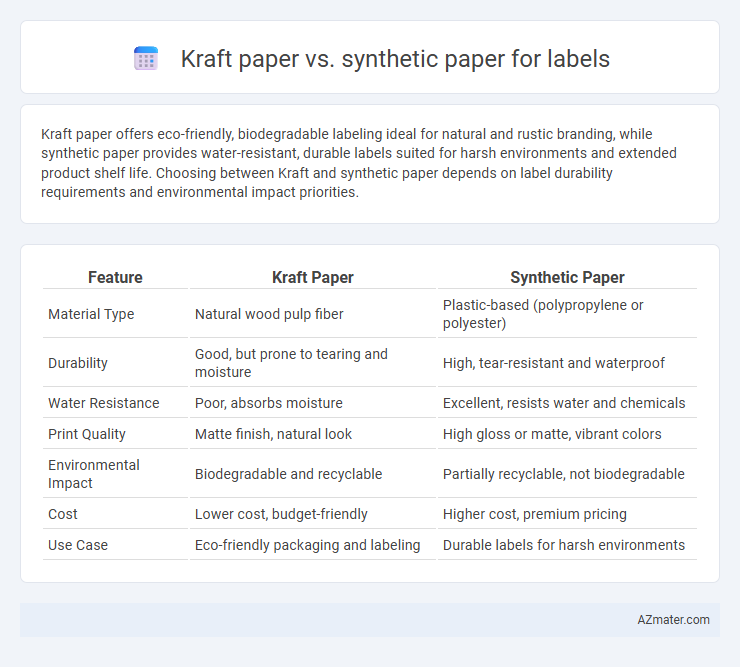Kraft paper offers eco-friendly, biodegradable labeling ideal for natural and rustic branding, while synthetic paper provides water-resistant, durable labels suited for harsh environments and extended product shelf life. Choosing between Kraft and synthetic paper depends on label durability requirements and environmental impact priorities.
Table of Comparison
| Feature | Kraft Paper | Synthetic Paper |
|---|---|---|
| Material Type | Natural wood pulp fiber | Plastic-based (polypropylene or polyester) |
| Durability | Good, but prone to tearing and moisture | High, tear-resistant and waterproof |
| Water Resistance | Poor, absorbs moisture | Excellent, resists water and chemicals |
| Print Quality | Matte finish, natural look | High gloss or matte, vibrant colors |
| Environmental Impact | Biodegradable and recyclable | Partially recyclable, not biodegradable |
| Cost | Lower cost, budget-friendly | Higher cost, premium pricing |
| Use Case | Eco-friendly packaging and labeling | Durable labels for harsh environments |
Introduction to Kraft Paper and Synthetic Paper Labels
Kraft paper labels are crafted from natural wood pulp, offering eco-friendly, biodegradable, and cost-effective solutions ideal for rustic and organic branding. Synthetic paper labels, made from durable polymers like polypropylene and polyethylene, provide superior resistance to water, chemicals, and tearing, ensuring longevity for outdoor and industrial use. Choosing between Kraft and synthetic paper depends on the label's intended application, durability needs, and environmental impact considerations.
Material Composition: Kraft Paper vs Synthetic Paper
Kraft paper is primarily composed of natural wood fibers, offering high strength and biodegradability, making it ideal for eco-friendly label applications. Synthetic paper, made from polypropylene or polyethylene resins, provides superior moisture resistance, durability, and tear strength compared to traditional kraft paper. The distinct material composition affects label performance, with kraft paper favored for sustainability and synthetic paper preferred for longevity in harsh conditions.
Visual Appeal and Print Quality Comparison
Kraft paper offers a natural, rustic texture enhancing brand authenticity but may limit color vibrancy and fine detail in print. Synthetic paper provides superior print quality with sharper images, brighter colors, and consistent surface finish, boosting label visibility and appeal. For high-resolution graphics and vibrant branding, synthetic paper outperforms kraft paper in visual impact.
Durability and Resistance to Environmental Factors
Kraft paper labels offer natural strength and biodegradability but are less resistant to moisture, chemicals, and UV exposure compared to synthetic paper labels. Synthetic paper, made from polypropylene or polyethylene, provides superior durability against water, oils, abrasion, and extreme temperatures, making it ideal for harsh environmental conditions. For applications requiring long-lasting labels with high resistance to environmental factors, synthetic paper is the optimal choice.
Cost Analysis: Kraft Paper vs Synthetic Paper Labels
Kraft paper labels generally offer a lower initial cost compared to synthetic paper labels, making them a budget-friendly choice for large-volume or short-term labeling needs. Synthetic paper labels incur higher upfront expenses due to their durable, water-resistant, and tear-proof properties, but often reduce long-term costs by minimizing label replacements and maintenance. Analyzing total cost of ownership, synthetic paper can deliver better value in harsh environments or products with extended shelf life, while kraft paper remains cost-effective for eco-friendly, temporary labeling solutions.
Sustainability and Eco-Friendliness
Kraft paper labels are highly sustainable, made from natural wood pulp and fully biodegradable, making them an excellent choice for eco-friendly packaging. Synthetic paper, while durable and water-resistant, typically consists of non-biodegradable plastic materials such as polypropylene, which complicates recycling and environmental impact. Brands seeking green labeling solutions prioritize kraft paper for its renewable sourcing and lower carbon footprint compared to synthetic alternatives.
Adhesion Performance on Various Surfaces
Kraft paper labels offer excellent adhesion on rough and porous surfaces such as cardboard, wood, and fabric due to their natural fiber composition and high absorbency. Synthetic paper labels provide superior adhesion on smooth, non-porous surfaces like plastics, glass, and metal, boasting enhanced water and chemical resistance for durable performance. The choice between kraft and synthetic paper labels depends on the substrate type, environmental conditions, and required longevity of the adhesion.
Application Suitability for Different Industries
Kraft paper labels excel in eco-conscious industries like organic food, beverages, and artisanal products due to their natural, biodegradable properties and rustic aesthetic. Synthetic paper labels are favored in automotive, chemical, and pharmaceutical sectors for their durability, water resistance, and chemical resistance, ensuring longevity in harsh environments. Industries requiring high-performance labels with resistance to tearing, moisture, and extreme conditions benefit significantly from synthetic paper, while kraft paper is ideal for sustainable branding and short-term use.
Customization and Design Flexibility
Kraft paper offers natural texture and eco-friendly appeal, making it ideal for rustic and artisanal label designs with limited color options and moderate customization. Synthetic paper provides superior durability, water resistance, and a smooth surface that supports high-resolution printing, vibrant colors, and intricate design details, allowing extensive customization for labels in demanding environments. Brands needing flexible design capabilities and long-lasting labels often prefer synthetic paper, while kraft paper suits those prioritizing sustainability and a natural aesthetic.
Final Considerations: Choosing the Right Label Material
Kraft paper offers an eco-friendly, biodegradable option with a natural aesthetic suitable for organic and artisanal products, while synthetic paper provides superior durability, water resistance, and tear-proof qualities ideal for outdoor or industrial labels. Final considerations include the label's exposure to environmental factors, required longevity, and brand image priorities, with synthetic paper excelling in harsh conditions and Kraft paper supporting sustainability goals. Choosing the right label material depends on balancing cost, performance needs, and environmental impact to ensure optimal functionality and consumer appeal.

Infographic: Kraft paper vs Synthetic paper for Label
 azmater.com
azmater.com